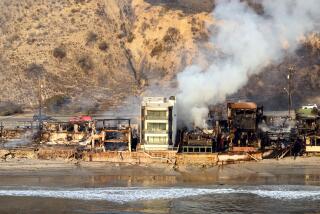Why some averted disaster
- Share via
For nearly an hour, Marianne Shannon thought Stevenson Ranch’s luck had run out.
The winds seemed so fast, much stronger than in 2003, when the last massive fire threatened her home. She watched from her cul-de-sac Monday afternoon as flames exploded just a few hundred feet away. A firefighter told her to take down her curtains to prevent them from igniting. Gusts knocked down the faux headstones she’d set up for Halloween.
Then as quickly as the danger came, the threat passed.
“The firemen were saying we were pretty well protected,” Shannon said.
Once again this 5,000 home master-planned community south of Santa Clarita emerged unscathed by fire.
California cannot avoid wildfires. But proper building techniques have proved to greatly reduce the threat to homes and businesses. Fire safety experts said Stevenson Ranch, and other modern communities like it, have made their own luck.
Precautions used there include fire-resistant materials such as concrete roof tiles, double-paned heat-resistant windows and enclosed eaves. A 200-foot greenbelt with fire-resistant plantings rings the property.
Additional buffers of stone and concrete culverts were constructed behind properties adjacent to canyons and other open land.
When it comes to saving homes and neighborhoods from fire, some developments are more equal than others. The story was the same this week in Orange County, where firefighters kept a raging 18,000-acre blaze from newer planned communities in Foothill Ranch, Irvine and Lake Forest.
As fire threatened the newer developments of Portola Springs and Northwood on Sunday, fire officials decided to let residents take shelter in their homes rather than evacuate them, Capt. Stephen Miller of the Orange County Fire Authority said Sunday from near the frontline.
“If we were not confident they would not be threatened, that we would not be able to save the homes, we would not put them in that situation,” Miller said.
But a significant number of California communities remain far short of such standards. Nearly 5 million homes in the state are at high to extreme risk from wildfires, and 84% of them are in urban areas abutting areas designated as wildlands, according to a report by the California Department of Forestry and Fire Protection. That report was published in October 2003, the month deadly fires swept through the state and into backyards of Stevenson Ranch homes.
Many fire-safe features in practice there are borne out of planning and building code changes enacted in the aftermath of devastating 1993 fires, said Ron Coleman, a former California state fire marshal and forestry and fire protection chief.
Higher standards will soon be required of all new building statewide, at least in the zones where fire risk is highest. The California Building Standards Commission last month approved standards recommended by the state fire marshal for buildings in fire hazard zones.
Those requirements are to go into effect in January 2008 in areas under state control, and after that date, any new permits issued in such zones will require that the new standards be met.
New construction under local control won’t have to meet the standards until July 2008, and then only buildings in “very high fire severity” zones must comply.
“The fact that a neighborhood will survive an assault by a fire is a combination of factors,” said Coleman, now vice president of Emergency Services Consulting Inc. in Elk Grove, Calif. “What I’m talking about is building tracts so there is defensible space built into the design, so access roads are built considering the need for fire engines to be coming in and evacuees going out.”
Changing building practices has not been easy, said Coleman, who noted that it has taken more than a decade for the concept of defensible space to win wide acceptance.
Given the state’s limited firefighting resources, he said, stringent requirements are needed. As the devastation this week made clear, there are too few fire crews to fight blazes block by block.
“Defensible space assumes someone is going to be there defending the house,” he said. “In my opinion, the home has to be survivable, and that means ignition-resistant construction that protects structures from radiant heat and embers.”
No one knows how many homeowners have done everything they can to protect their homes from wildfire. In a study released Tuesday, the nonprofit Natural Resources Defense Council examined the fire preparedness of the Love Creek neighborhood in Avery, a town in the central Sierra Nevada range. The community has about 50 homes built between 1940 and 2001 and was chosen because researchers considered it typical for mountain towns.
“Not one home . . . complied with all the basic standards necessary to ensure survival from a forest fire,” the report’s authors wrote. “Every home assessed failed multiple safety measures.”
The estimate for bringing residences up to minimum standards averaged about $2,500, with $4,500 more needed, on average, to clear vegetation.
Experts say fire protection efforts need to be communitywide to be effective.
In neighborhoods that have been hard-hit by fire, “you will find that some individual property owners did everything they could to protect their property but were endangered by neighbors who didn’t,” Coleman said.
Many homeowners ordered to evacuate make costly mistakes, Coleman said, leaving windows or garage doors open, not clearing flammable items from near the house. Even something as simple as using tinfoil to reflect the heat from windows facing a down slope can decrease the likelihood of a home’s igniting, he said.
Firefighters say neighborhoods and homes that appear girded for fire are more likely to be defended when hard choices about resources need to be made. Well-designed communities are also less likely to require evacuations, even when blazes get close.
In Stevenson Ranch, where red fire retardant stained the nearby hillsides and residents had garden hoses ready to douse flying embers, resident Laurie Sarman said firefighters deployed to her cul-de-sac did not seem worried. One firefighter reassured her.
“He was confident, even in the winds, that our house wasn’t going anywhere,” said Sarman, who lived there through the 2003 scare as well.
On Tuesday, life seemed mostly back to normal in Stevenson Ranch. Couples walked their dogs, joggers crossed the neighborhood and children skateboarded, their schools closed for the day.
Eating al fresco at a cafe off Stevenson Ranch Parkway, Mike and Monika Cook said that between the firefighters and the precautions already taken, they were not worried.
Just as they are most days, landscapers were out working, with sprinklers watering surrounding grounds. The homeowners association newsletter published earlier in the year urged residents to call if they saw any thick vegetation so it could be taken away.
“They’ve got it under control,” said Monika Cook, her dog Buddy panting by her side. “The homeowners association keeps the brush clear. They don’t leave it to residents to do it.”
For Sarman, who admits to “freaking out” during the 2003 fires, this week proved less stressful. That close call, she said, was an awakening.
“We just didn’t think about it [before]. It never crossed our minds. I mean, what’s brush?” she said.
Now educated, Sarman surveyed her property with a new eye.
“We have a nice line of defense,” she said.
Times staff writer Hector Becerra contributed to this report.
More to Read
Sign up for Essential California
The most important California stories and recommendations in your inbox every morning.
You may occasionally receive promotional content from the Los Angeles Times.











